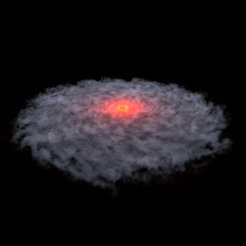First radio detection of lonely planet disk shows similarities between stars and planet-like objects
| Background information | Download area | In-depth description of the results |

A new study of the lonely, planet-like object OTS44 has provided evidence that this object has formed in a similar way as ordinary stars and brown dwarfs – a surprising result that challenges current models of star and planet formation. The study by a group of astronomers, led by Amelia Bayo of the University of Valparaiso and involving several astronomers from the Max Planck Institute for Astronomy, used the ALMA observatory in Chile to detect dust from the disk surrounding OTS44.
This detection yielded mass estimates for the dust contained in the disk, which place OTS44 in a row with stars and brown dwarfs (that is, failed stars with too little mass for sustained nuclear fusion): All these objects, it seems, have rather similar properties, including a similar ratio between the mass of dust in the disk and the mass of the central object. The findings supplement earlier research that found OTS44 is still growing by drawing matter from its disk onto itself – another tell-tale similarity between the object and young stars.
Similarities with young stars
Taken together, this is compelling evidence that OTS44 formed in the same way as stars and brown dwarfs, namely by the collapse of a cloud of gas and dust. But going by current models of star and planet formation, it should not be possible for an object as low-mass as OTS44 to form in this way. An alternative way, the formation of multiple objects in one go, with low-mass objects like OTS44 among them, is contradicted by the observations, which show no such companion objects anywhere near OTS44.
The strength of the radiation received from the dust at millimetre wavelength also suggests the presence of large, millimetre sized dust grains. This, too, is surprising. Under the conditions in the disk of a low-mass object, dust is not expected to clump together to reach this size (or beyond). Instead, the OTS44 dust grains appear to be growing – and might even be on the way of forming a mini-moon around the object; another similarity with stars and their planetary systems.
Amelia Bayo (University of Valparaiso), who led this research effort, says: “The more we know about OTS44, the greater its similarities with a young star. But its mass is so low that theory tells us it cannot have formed like a star!”
Thomas Henning of the Max Planck Institute for Astronomy adds: “It is amazing how an observatory like ALMA allows us to see half an Earth mass worth of dust orbiting an object with ten times the mass of Jupiter at a distance of 500 light-years. But the new data also shows the limit of our understanding. Clearly, there is still a lot to learn about the formation of low-mass astronomical objects!”
Background information
The work described here has been published as A. Bayo et al., "First millimeter detection of the disk around a young, isolated, planetary-mass object" in the May 18, 2017 edition of the Astrophysical Journal Letters.
The MPIA researchers involved are
Viki Joergens, Yao Liu (also Purple Mountain Observatory, Nanjing, China), Johan Oloffson (also Universidad de Valparaíso), Thomas Henning, and Henrik Beuther
in collaboration with
Amelia Bayo (first author; Universidad de Valparaíso [UV]), Robert Brauer (University of Kiel), Javier Arancibia (UV), Paola Pinilla (University of Arizona), Sebastian Wolf, Jan Philipp Ruge (both University of Kiel), Antonella Natta (Dublin Institute for Advanced Studies and INAF-Osservatorio Astrofisico di Arcetri), Katharine G. Johnson (University of Leeds), Mickael Bonnefoy (IPAG Grenoble), and Gael Chauvin (IPAG Grenoble and Unidad Mixta Internacional Franco-Chilena de Astronomía, Santiago).
Additional figures and download

